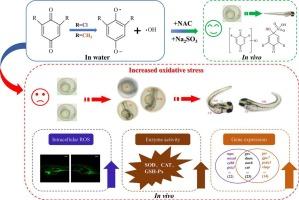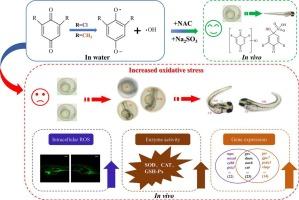Ecotoxicological assessment of p-benzoquinone oxidation byproducts in water treatment systems: oxidative stress responses and mechanisms
IF 9.7
1区 环境科学与生态学
Q1 ENVIRONMENTAL SCIENCES
引用次数: 0
Abstract
p-Benzoquinone analogues, a class of ubiquitous oxidation byproducts, are increasingly detected in effluents from various oxidative treatment systems. While halogenated derivatives have received substantial research attention, the ecotoxicological impacts of non-halogenated analogues—particularly in vivo—remain poorly characterized. This study systematically compared the toxicity of 2,6-dichloro-p-benzoquinone (2,6-DCBQ) and 2,6-dimethyl-p-benzoquinone (2,6-DMBQ) using zebrafish embryos. 2,6-DMBQ exhibited comparable lethality to 2,6-DCBQ (48 h EC50 = 221.72 vs. 169.17 μg/L), with developmental malformations of cardiac edema and notochord malformation mainly emerging in juvenile fish at 250 μg/L. Exposure to 2,6-DCBQ of 2.5 μg/L and 2,6-DMBQ of 25 μg/L induced significant oxidative stress, elevating reactive oxygen species (ROS) levels and upregulating antioxidant enzymes of total superoxide dismutase, catalase, and glutathione peroxidase. PCR gene chip analysis showed that 23 oxidative stress-related genes were coordinately upregulated in both treatment groups. Co-exposure with N-acetylcysteine (20 μM) or Na2SO3 (Na2SO3:p-BQs = 10:1) synergistically mitigated toxicity of 2,6-DCBQ and 2,6-DMBQ at 250 μg/L, restoring morphological and biochemical endpoints to control levels. Electron paramagnetic resonance confirmed semiquinone radicals and hydroxyl radicals as key drivers of ROS amplification. These findings establish radical-mediated mechanisms as critical toxicological pathways and inform risk management strategies for quinoid byproducts in water treatment systems.


水处理系统中对苯醌氧化副产物的生态毒理学评价:氧化应激反应和机制
对苯醌类似物是一类普遍存在的氧化副产物,在各种氧化处理系统的出水中越来越多地被检测到。虽然卤化衍生物已经得到了大量的研究关注,但非卤化类似物的生态毒理学影响-特别是在体内-仍然缺乏表征。本研究系统比较了2,6-二氯对苯醌(2,6- dcbq)和2,6-二甲基对苯醌(2,6- dmbq)对斑马鱼胚胎的毒性。2,6- dmbq的致死率与2,6- dcbq相当(48 h EC50 = 221.72 vs. 169.17 μg/L), 250 μg/L时幼鱼主要出现心脏水肿和脊索畸形等发育畸形。2,6- dcbq浓度为2.5 μg/L和2,6- dmbq浓度为25 μg/L诱导了显著的氧化应激,活性氧(ROS)水平升高,总超氧化物歧化酶、过氧化氢酶和谷胱甘肽过氧化物酶的抗氧化酶水平上调。PCR基因芯片分析显示,两个治疗组有23个氧化应激相关基因协同上调。与n -乙酰半胱氨酸(20 μM)或Na2SO3 (Na2SO3:p-BQs = 10:1)共暴露在250 μg/L时可协同减轻2,6- dcbq和2,6- dmbq的毒性,使形态学和生化终点恢复到控制水平。电子顺磁共振证实了半醌自由基和羟基自由基是ROS扩增的关键驱动因素。这些发现确定了自由基介导的机制是关键的毒理学途径,并为水处理系统中类醌副产物的风险管理策略提供了信息。
本文章由计算机程序翻译,如有差异,请以英文原文为准。
求助全文
约1分钟内获得全文
求助全文
来源期刊

Environment International
环境科学-环境科学
CiteScore
21.90
自引率
3.40%
发文量
734
审稿时长
2.8 months
期刊介绍:
Environmental Health publishes manuscripts focusing on critical aspects of environmental and occupational medicine, including studies in toxicology and epidemiology, to illuminate the human health implications of exposure to environmental hazards. The journal adopts an open-access model and practices open peer review.
It caters to scientists and practitioners across all environmental science domains, directly or indirectly impacting human health and well-being. With a commitment to enhancing the prevention of environmentally-related health risks, Environmental Health serves as a public health journal for the community and scientists engaged in matters of public health significance concerning the environment.
 求助内容:
求助内容: 应助结果提醒方式:
应助结果提醒方式:


